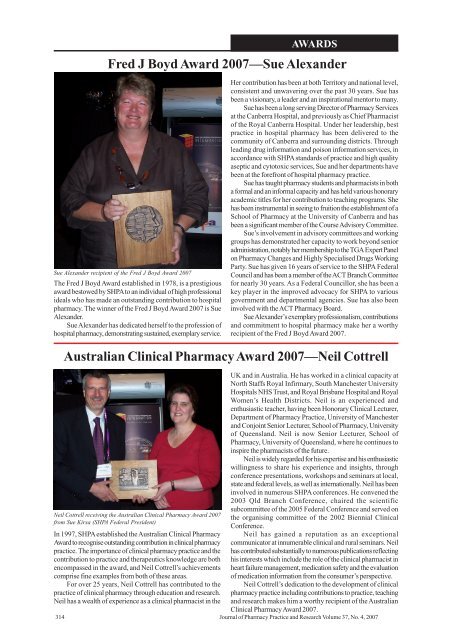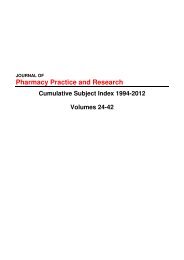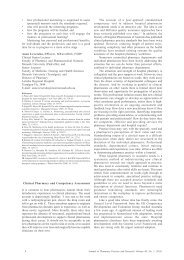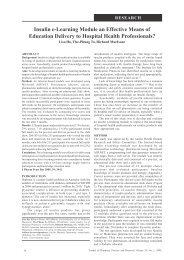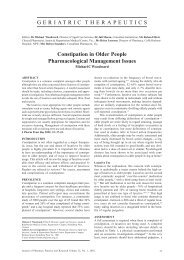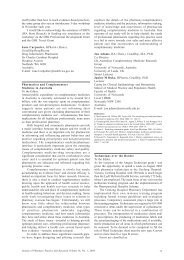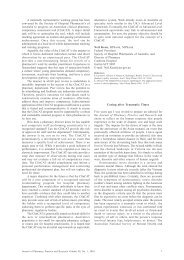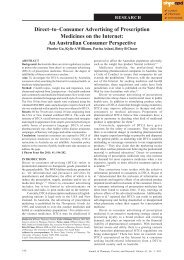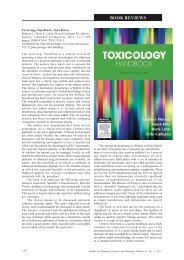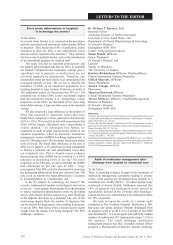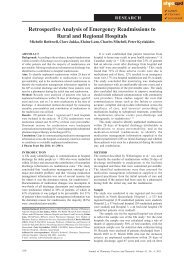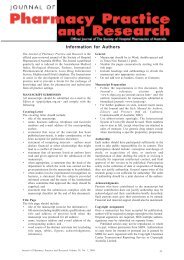Fred J Boyd 2007 Award - jppr
Fred J Boyd 2007 Award - jppr
Fred J Boyd 2007 Award - jppr
Create successful ePaper yourself
Turn your PDF publications into a flip-book with our unique Google optimized e-Paper software.
The <strong>Fred</strong> J <strong>Boyd</strong> <strong>Award</strong> established in 1978, is a prestigious<br />
award bestowed by SHPA to an individual of high professional<br />
ideals who has made an outstanding contribution to hospital<br />
pharmacy. The winner of the <strong>Fred</strong> J <strong>Boyd</strong> <strong>Award</strong> <strong>2007</strong> is Sue<br />
Alexander.<br />
Sue Alexander has dedicated herself to the profession of<br />
hospital pharmacy, demonstrating sustained, exemplary service.<br />
AWARDS<br />
<strong>Fred</strong> J <strong>Boyd</strong> <strong>Award</strong> <strong>2007</strong>—Sue Alexander<br />
Sue Alexander recipient of the <strong>Fred</strong> J <strong>Boyd</strong> <strong>Award</strong> <strong>2007</strong><br />
Her contribution has been at both Territory and national level,<br />
consistent and unwavering over the past 30 years. Sue has<br />
been a visionary, a leader and an inspirational mentor to many.<br />
Sue has been a long serving Director of Pharmacy Services<br />
at the Canberra Hospital, and previously as Chief Pharmacist<br />
of the Royal Canberra Hospital. Under her leadership, best<br />
practice in hospital pharmacy has been delivered to the<br />
community of Canberra and surrounding districts. Through<br />
leading drug information and poison information services, in<br />
accordance with SHPA standards of practice and high quality<br />
aseptic and cytotoxic services, Sue and her departments have<br />
been at the forefront of hospital pharmacy practice.<br />
Sue has taught pharmacy students and pharmacists in both<br />
a formal and an informal capacity and has held various honorary<br />
academic titles for her contribution to teaching programs. She<br />
has been instrumental in seeing to fruition the establishment of a<br />
School of Pharmacy at the University of Canberra and has<br />
been a significant member of the Course Advisory Committee.<br />
Sue’s involvement in advisory committees and working<br />
groups has demonstrated her capacity to work beyond senior<br />
administration, notably her membership to the TGA Expert Panel<br />
on Pharmacy Changes and Highly Specialised Drugs Working<br />
Party. Sue has given 16 years of service to the SHPA Federal<br />
Council and has been a member of the ACT Branch Committee<br />
for nearly 30 years. As a Federal Councillor, she has been a<br />
key player in the improved advocacy for SHPA to various<br />
government and departmental agencies. Sue has also been<br />
involved with the ACT Pharmacy Board.<br />
Sue Alexander’s exemplary professionalism, contributions<br />
and commitment to hospital pharmacy make her a worthy<br />
recipient of the <strong>Fred</strong> J <strong>Boyd</strong> <strong>Award</strong> <strong>2007</strong>.<br />
Australian Clinical Pharmacy <strong>Award</strong> <strong>2007</strong>—Neil Cottrell<br />
UK and in Australia. He has worked in a clinical capacity at<br />
North Staffs Royal Infirmary, South Manchester University<br />
Hospitals NHS Trust, and Royal Brisbane Hospital and Royal<br />
Women’s Health Districts. Neil is an experienced and<br />
enthusiastic teacher, having been Honorary Clinical Lecturer,<br />
Department of Pharmacy Practice, University of Manchester<br />
and Conjoint Senior Lecturer, School of Pharmacy, University<br />
of Queensland. Neil is now Senior Lecturer, School of<br />
Pharmacy, University of Queensland, where he continues to<br />
inspire the pharmacists of the future.<br />
Neil is widely regarded for his expertise and his enthusiastic<br />
willingness to share his experience and insights, through<br />
conference presentations, workshops and seminars at local,<br />
state and federal levels, as well as internationally. Neil has been<br />
involved in numerous SHPA conferences. He convened the<br />
2003 Qld Branch Conference, chaired the scientific<br />
subcommittee of the 2005 Federal Conference and served on<br />
Neil Cottrell receiving the Australian Clinical Pharmacy <strong>Award</strong> <strong>2007</strong><br />
the organising committee of the 2002 Biennial Clinical<br />
from Sue Kirsa (SHPA Federal President)<br />
Conference.<br />
In 1997, SHPA established the Australian Clinical Pharmacy Neil has gained a reputation as an exceptional<br />
<strong>Award</strong> to recognise outstanding contribution in clinical pharmacy communicator at innumerable clinical and rural seminars. Neil<br />
practice. The importance of clinical pharmacy practice and the has contributed substantially to numerous publications reflecting<br />
contribution to practice and therapeutics knowledge are both his interests which include the role of the clinical pharmacist in<br />
encompassed in the award, and Neil Cottrell’s achievements heart failure management, medication safety and the evaluation<br />
comprise fine examples from both of these areas.<br />
of medication information from the consumer’s perspective.<br />
For over 25 years, Neil Cottrell has contributed to the Neil Cottrell’s dedication to the development of clinical<br />
practice of clinical pharmacy through education and research. pharmacy practice including contributions to practice, teaching<br />
Neil has a wealth of experience as a clinical pharmacist in the and research makes him a worthy recipient of the Australian<br />
Clinical Pharmacy <strong>Award</strong> <strong>2007</strong>.<br />
314<br />
Journal of Pharmacy Practice and Research Volume 37, No. 4, <strong>2007</strong>
GlaxoSmithKline Medal of Merit <strong>2007</strong>—Rosemary Burke<br />
The GlaxoSmithKline Medal of Merit is awarded annually for<br />
outstanding service to Australian hospital pharmacy. For her<br />
significant contributions to hospital pharmacy and ongoing efforts<br />
to improve safety for patients, Rosemary Burke, Director of<br />
Pharmacy, Concord Hospital is the recipient of the<br />
GlaxoSmithKline Medal of Merit <strong>2007</strong>.<br />
Rosemary has made an outstanding contribution to the<br />
practice of hospital pharmacy over many years. She has been<br />
active in education and training of pharmacists and graduates,<br />
in the workplace and the wider health community. Since 1997,<br />
Rosemary has actively contributed to the Pharmacy Board of<br />
NSW, not only participating in graduate review processes but<br />
also contributing a hospital pharmacy perspective to course<br />
structure revision and site evaluations for educational facilities.<br />
Rosemary has been a member of SHPA since 1988.<br />
Between 1996 and 2001, she was a member of the NSW<br />
Branch Committee and was Chair from 1997. Rosemary<br />
continues to provide advice to the Branch Committee and has<br />
been a member of the organising committees for the 4th SHPA<br />
Biennial Clinical Conference and the 28th Federal Conference.<br />
Since 2002, she has shared her knowledge and experience<br />
by leading the SHPA Medication Safety Committee of<br />
Specialty Practice. In her workplace she has demonstrated<br />
leadership by ensuring the appointment of an Area-Wide Quality<br />
Use of Medicines Pharmacist to coordinate action across a<br />
number of hospital facilities. She has also attracted some<br />
significant grants to progress multidisciplinary medication safety<br />
initiatives in her local environment led by hospital pharmacists.<br />
Since 1994, Rosemary has been a member of the NSW<br />
TAG and a member of the NSW TAG Management Committee<br />
since 2002. Rosemary has been a member of the NSW TAG<br />
Safer Medicines Group since its inception in 2004 and has<br />
participated in a number of key working groups. In 2005, she<br />
was a member of the NSW TAG Australian Advisory Panel<br />
for adaptation of the ISMP Medication Safety Self Assessment<br />
tools for use in Australian hospitals. Rosemary has also been a<br />
member of the Project Steering Committee for the NSW TAG<br />
Performance Indicator and Medication Safety Project which,<br />
during 2006 and <strong>2007</strong>, has developed Indicators for Quality<br />
Use of Medicines in Australian hospitals.<br />
It is an honour and a privilege to accept the <strong>Fred</strong> J <strong>Boyd</strong> <strong>Award</strong>.<br />
I feel extremely humble to be among the many distinguished<br />
recipients of this and the Glaxo Medal of Merit and Clinical<br />
Pharmacy <strong>Award</strong>s. I recognise that there are many more<br />
deserving members who have given outstanding service to our<br />
profession and the Society in particular, and I hope your work<br />
and commitment will be duly recognised. It is a very proud<br />
moment for me. I wish to thank the members of the ACT<br />
Branch, in particular the Chairman, Andrew Matthews, who<br />
nominated me, and then with great determination and trickery,<br />
convinced me to accept the nomination.<br />
Sue Alexander, BPharm, Pharmacist, The Canberra Hospital, Garran,<br />
Australian Capital Territory<br />
Address for correspondence: Sue Alexander, Pharmacy Department, The<br />
Canberra Hospital, Garran ACT 2605, Australia<br />
E-mail: Susan.Alexander@act.gov.au<br />
<strong>Fred</strong> J <strong>Boyd</strong> <strong>Award</strong> Oration<br />
Susan Alexander<br />
Rosemary Burke recipient of the GlaxoSmithKline Medal of Merit<br />
<strong>2007</strong><br />
Rosemary is currently collaborating with investigators to<br />
evaluate the impact of electronic medication management<br />
systems on work practices, pharmacy activities, medication<br />
errors and patient safety. Rosemary has been instrumental in<br />
engaging decision-makers in hospital and government to<br />
recognise the role of hospital pharmacists in realising the safety<br />
outcomes that electronic systems are expected to facilitate.<br />
The GlaxoSmithKline Medal of Merit <strong>Award</strong> for <strong>2007</strong> is<br />
awarded in recognition of Rosemary’s continuing achievements<br />
in supporting the development of hospital pharmacy.<br />
I would also like to thank the pharmacy staff at The<br />
Canberra Hospital and Neil Keen, the new Director of<br />
Pharmacy. He is one of our Federal Councillors and the<br />
Chairman of the SHPA Division of Education. I have had the<br />
luxury and support of Neil and the hospital to phase my<br />
retirement from The Canberra Hospital over the past year.<br />
While ostensibly I have been there to handover, and<br />
provide support and advice to Neil and the staff, I have also<br />
been able to indulge in my favourite job of working in the<br />
dispensary and directly looking after patients. It has probably<br />
been frustrating for the rest of the staff though. I often hear,<br />
‘Ask Sue, this phone’s for Sue, where’s Sue?’ and there I am<br />
at the pharmacy counter, talking to a patient, planning to meet<br />
up in Paris with one of our renal transplant patients who has<br />
been posted to the Embassy there, or talking to Richard (who<br />
prefers to be called Rachael), about his CD4 count and the<br />
latest movies.<br />
Journal of Pharmacy Practice and Research Volume 37, No. 4, <strong>2007</strong> 315
Last week (coincidentally at the same time) two adult CF<br />
patients who have had lung transplants presented their S100<br />
prescriptions to me. I have known both of them since they<br />
were children in the 1970s, when I worked in the CF clinic at<br />
Royal Canberra Hospital as a paediatric pharmacist. I was<br />
thrilled to be able to take the time to talk to them both again.<br />
Needless to say, every day, I find it a thrill to work in the<br />
dispensary, not only because of contact with the patients, but<br />
because of being ‘hands-on’ again, working with a wonderful<br />
team of technicians and pharmacists and being able to mentor<br />
the graduates and students.<br />
Anyway, I have digressed from what I wanted to talk about<br />
today, which is not about succession planning (although I can<br />
highly recommend it), but about the changes I have experienced<br />
in the past 30 years of my career, and how SHPA has been<br />
there to guide and support me.<br />
Neil asked me a couple of weeks ago if there were<br />
computers when I started in Pharmacy. The answer was a<br />
resounding ‘no’. I was still using a slide-rule, let alone a<br />
calculator, when I did my final pharmacy exams in 1974. He<br />
followed on with the question ‘well, did you have self adhesive<br />
labels then?’ My answer was ‘yes’. We fed the roll through the<br />
typewriter to type our labels and they kept getting stuck on the<br />
roll, so you had to constantly pull the typewriter apart. In 1978,<br />
we did acquire an electric typewriter with a memory that stored<br />
information on a magnetic tape and improved the efficiency of<br />
typing labels (but you still needed two fingers). I seem to<br />
remember that this was about the time that we recruited our<br />
first dispensary assistant to type the labels for us.<br />
It is amazing to think we progressed from typewriters to<br />
the sophisticated computer systems we have now, in just 20<br />
years. In 1985, the Australian Journal of Hospital Pharmacy<br />
(AJHP) published an article called ‘Consideration of<br />
applications and financial benefits of computer systems in<br />
hospital pharmacy’, and indeed, the theme of the 1987 Federal<br />
Conference in Hobart was ‘Basics to Basic’ with a strong<br />
emphasis on computer applications and justification. An AJHP<br />
editorial in 1987, described the role of computerisation in the<br />
continuing development of hospital pharmacy practice. In the<br />
same year the SHPA guidelines for the implementation of<br />
computer systems in hospital pharmacy were published, and<br />
the early 90s saw a proliferation of articles on a variety of<br />
programs, mostly developed in-house, with applications<br />
involving discharge prescriptions, printing of dispensary and<br />
IV admixture labels, stock control and formulation of TPNs.<br />
We acquired our first computer system in 1990 following<br />
the principles set out in the SHPA document to guide our<br />
selection. It printed dispensing labels, kept patient histories,<br />
produced picking slips for imprest supplies, printed orders for<br />
suppliers and provided a range of reports on drug usage.<br />
It is interesting that just as we all widely discussed,<br />
published on, and looked to pharmacy systems in the 90s, the<br />
same thing is being repeated today with electronic prescribing<br />
and medication management systems.<br />
I don’t want to delve too much into the history of clinical<br />
pharmacy; however, I would like to say that my first job in<br />
1975 at the now non-existent Royal Canberra Hospital was as<br />
a ward pharmacist. Sure, our job involved replenishing the<br />
imprest stock and ward housekeeping, but we did review every<br />
chart every day (called treatment sheets then), primarily to<br />
identify and dispense the non-stock items. My boss then, Mrs<br />
Enid Barnes, was very progressive, and had already introduced<br />
a distribution system based on limited imprest stock and<br />
individual patient dispensing. It was a rudimentary review of<br />
the chart—we checked for legibility, completeness, drug<br />
316<br />
interactions and correct dosages, and that the nurses had<br />
administered all the doses. In 1975, the chart had no duplicate<br />
and we transposed the orders. I introduced one duplicate in<br />
1985 that went backwards and forwards from the pharmacy<br />
to the wards, five duplicates in 1991 and now we are back to<br />
no duplicates. The clinical pharmacist scans the original order<br />
directly into the dispensary from the ward. And might I say,<br />
what a great achievement for us to now have the same<br />
medication chart in every public hospital in Australia!<br />
As a ward pharmacist in 1975, we taught extensively in<br />
pharmacology and therapeutics, because nurse training in those<br />
days was hospital based, and we instilled into the nurses the<br />
principles of right patient, right drug, right dose, right time, and<br />
right route. I am not sure that their training in this regard is as<br />
good today.<br />
The SHPA Ward Pharmacy Action Committee (which was<br />
the precursor to the Specialty Practice Committee) was formed<br />
in 1976 to facilitate the interchange of experience and ideas. In<br />
1980, six clinical roles were defined for ward pharmacists in<br />
the Journal: evaluating drug therapy orders, noting potential<br />
problems relating to drug therapy and selecting parameters for<br />
monitoring, coordinating the collection of ADR reports,<br />
providing drug information and collecting drug usage statistics.<br />
In 1982, an Australia wide survey, which was published in the<br />
AJHP, showed that 60% of beds were covered by a ward<br />
pharmacist doing these jobs, albeit the average number of beds<br />
per pharmacist was 100, and the average time taken per bed<br />
was 2 to 3.9 minutes, 23% took less than 2 minutes.<br />
As ward pharmacists back then, we didn’t often talk to<br />
patients, charts were centralised at the nurses’ station so we<br />
didn’t really have a reason to go into their rooms. The shift<br />
from changing the terminology from ward to clinical pharmacist<br />
came with our increasing interaction with the patients during<br />
the 1980s and like other hospitals we changed to having the<br />
charts on the ends of the beds. The first SHPA policy guidelines<br />
for the practice of clinical pharmacy were published in 1986.<br />
This was the first document to define clinical pharmacy and list<br />
those activities required of a clinical pharmacist.<br />
Drug information developed as a specialty during the 1980s<br />
as a response to providing a depth of expertise to increasingly<br />
complex clinical questions. Canberra hosted the first drug<br />
information seminar when the Commonwealth’s National Drug<br />
Information Service was established in the late 1970s. We called<br />
the conference, ‘Alice in Wonderland’. In 1980, the Drug<br />
Information COSP was formed, minimum practice guidelines<br />
were published in 1983, and by the mid 1980s most major<br />
hospitals had established drug information centres.<br />
While talking about the establishment of drug information<br />
centres, I cannot miss mentioning the establishment of centralised<br />
IV admixture services in the late 70s. This is the specialty service<br />
to which I feel I have contributed the most in my career, and<br />
before becoming a Deputy Chief Pharmacist in 1980, was my<br />
area of specialty. In Canberra, under the stewardship of the<br />
great Mel Davis, the Parenteral Services Action Committee,<br />
with an oncology subgroup, was established in 1978. In 1979,<br />
we published on justifying and establishing IV additive services,<br />
published aseptic dispensing guidelines and conducted aseptic<br />
dispensing courses for pharmacists and technicians from around<br />
Australia. From 1977 to 1980, involvement of pharmacists in<br />
oncology services was a major growth area. Centralised<br />
cytotoxic reconstitution was first seen as a role for the IV additive<br />
service and became a major area of aseptic dispensing, but in<br />
1980, it was identified that this may not be without its problems<br />
and the occupational hazards were recognised. It was the<br />
Parenteral Services COSP based in Canberra that first published<br />
Journal of Pharmacy Practice and Research Volume 37, No. 4, <strong>2007</strong>
the guidelines for safe handling of cytotoxic drugs in pharmacy<br />
departments and hospital wards; they were updated in 1982<br />
to include the recommendation of using a laminar flow cytotoxic<br />
drug safety cabinet.<br />
Unfortunately, the 80s were also the era of economic<br />
rationalism, recurrent cost-containment measures, Booz-Allen<br />
reviews, and perceived fat trimming. We struggled to justify<br />
the costs of clinical pharmacists. In 1985, the year I was<br />
appointed as Chief Pharmacist, there were no fewer than eight<br />
articles published in the AJHP on clinical pharmacist workloads<br />
and activities, and the first costing study was published to<br />
demonstrate cost justification of clinical services. These surveys<br />
and activities, published and promoted by SHPA, assisted<br />
pharmacy managers to promote clinical pharmacy as part of a<br />
comprehensive pharmacy service.<br />
Chris Doecke, at the 1991 Federal Conference, heralded<br />
the path of clinical pharmacy in the 1990s by asking the<br />
question, ‘Why are we still talking about putting theory into<br />
practice after 20 years. We must move to measuring<br />
improvement in patient outcomes, ensuring the quality of our<br />
services, focus on appropriate drug use and collaborate in<br />
changing prescribing practices’.<br />
Quality Assurance, Total Quality Management, and Quality<br />
Use of Medicines thus became the themes of the late 80s and<br />
90s, focusing on not what we did, but what we achieved. Many<br />
initiatives were published and taken up to promote Quality Use<br />
of Medicines. In 1992, the Quality Assurance COSP published<br />
the first SHPA performance indicators and in 1996 Standards<br />
of Practice for Drug Usage Review were published. In 1993,<br />
pharmacoeconomics was the theme of the Sydney Federal<br />
Conference. There were many attempts, facilitated by SHPA,<br />
to train us in drug use economics, quality of life year assessments,<br />
decision analysis, pharmacoeconomic evaluations, and we tried<br />
to apply these principles to our drug and therapeutic committee<br />
decisions—in my case, a miserable failure.<br />
In the 90s we were called upon to provide evidence of<br />
the value of clinical pharmacy services. SHPA was unwavering<br />
in its support for pharmacy managers and in 1998 commissioned<br />
the clinical pharmacy intervention study demonstrating that<br />
routine review of patient drug therapy saves lives, improves<br />
patient care, reduces length of stay and saves money. Although,<br />
by the start of the new millennium, the quality and safety agenda<br />
had been taken up and clinical pharmacists were indelibly<br />
viewed as critical to safe medication practices, the study, finally<br />
published in 2003, confirmed the Safety and Quality Council’s<br />
view that the provision of clinical pharmacy services reduces<br />
medication incidents.<br />
This leads me to mention the overall health policy changes<br />
that have impacted over the past three decades on our ability<br />
to get on with saving lives. Although, I thought we did pretty<br />
well in the 70s (after all, it was before ACT self government<br />
and Royal Canberra Hospital was Commonwealth funded with<br />
what seemed like unlimited resources), the 1980s were times<br />
of constant change; curtailed staff levels, workload growth,<br />
oppressive financial restrictions, hospital closures (including my<br />
own, Royal Canberra Hospital) and amalgamations which led<br />
to major upheavals of pharmacy departments. In the 1990s,<br />
changing organisational structures in hospitals affected most<br />
pharmacies. Organisation restructuring was a feature of the<br />
1995 Federal Conference in Melbourne. There was much<br />
debate in the AJHP about whether we should join an allied<br />
health division. There were issues of power and politics, seeking<br />
of greater recognition and greater resource allocation. There<br />
was the emergence of alternatives to the functionally based<br />
divisional structures to product-focused or matrix structures,<br />
with decentralised management and devolvement of costs.<br />
We also had DRGs, clinical costings, cost weights and<br />
casemix funding to contend with in the 90s, SHPA again being<br />
heavily involved in supporting pharmacy managers with these<br />
new considerations. And thence to the jargon of the new century:<br />
clinical streaming, patient-centred care, service integration,<br />
organisational capability, clinical and corporate governance,<br />
stakeholders, benchmarking, accountability, clinical risk<br />
management, frameworks, clinical and non-clinical outputs,<br />
flexible models. I would like to quote from ACT Health’s current<br />
Quality and Safety Strategic Plan: ‘The clinical governance<br />
framework has been established to provide explicit lines of<br />
accountability with a clearly defined management structure that<br />
allows facilitation, coordination, monitoring, evaluation and<br />
feedback of the services provided, and is based on a set of<br />
guiding dimensions to quality and safety that are built around<br />
four key interlocked strategic areas; clinical competence, clinical<br />
effectiveness, clinical risk management and system enhancement<br />
and accountability’. Well, good luck Neil!<br />
My message in mentioning just a few of the changes that<br />
our profession has seen over the period of my career is in the<br />
following questions: How did I manage these changes? How<br />
was I able to adapt to change? How did I find the information<br />
and gain the knowledge and competence to facilitate such<br />
changes? How did I become informed and educated in order<br />
to progress and introduce new services?<br />
The answer is SHPA. SHPA provides us conferences,<br />
seminars, lectures, the Journal, the bulletin, COSPs, guidelines,<br />
position statements, grants and awards, and advocacy to name<br />
but a few things. It provides us with the opportunities to build<br />
awareness and an understanding of the current environment,<br />
for networking, for sharing experiences, disseminating<br />
information, making lifelong friends and contacts, for learning<br />
and providing the know-how to institute change, progress and<br />
improve. Or to quote from the current CPD program it keeps<br />
us current, informed and connected.<br />
My career was and still is, inextricably tied to being a<br />
member of and being involved with SHPA. I am proud to have<br />
served on Federal Council, the State Branch Committee and<br />
various COSPs and to be involved with educating and informing<br />
others. However, I can’t begin to say how valuable that<br />
involvement has been to my own career. Being so well informed<br />
through this involvement has meant that I have been able to<br />
facilitate change, develop, and improve the services in the<br />
hospitals that I have worked.<br />
SHPA provides the way that our profession communicates<br />
and informs; so I urge you to get involved, give back to SHPA<br />
some of what it has given you. I know this will be a hard<br />
concept to grasp for the members of the Y generation in the<br />
audience, but I urge you to think about, not what SHPA can<br />
do for you, but what you can do for it.<br />
In closing I would like to use the words of the late Pam<br />
Nieman when she accepted this award in 1995 (and she would<br />
be very upset about missing this Conference). ‘We owe a debt<br />
to our profession. It serves us well through our lifetime —so<br />
we must give back to it’.<br />
Thank you SHPA, which is all of you, for what you have<br />
done for me.<br />
Sue Alexander delivered her oration on 10 November <strong>2007</strong><br />
at the 28th SHPA Federal Conference in Sydney.<br />
Journal of Pharmacy Practice and Research Volume 37, No. 4, <strong>2007</strong> 317
318<br />
GlaxoSmithKline Medal of Merit Oration<br />
Rosemary Burke<br />
Firstly, I would like to thank the NSW Branch for nominating<br />
me, Federal Council for selecting me and GSK for sponsoring<br />
the award. I am honoured to receive it and feel quite humbled<br />
because peer recognition is the highest form of recognition.<br />
My background is of one who grew up with a father as a<br />
pharmacist and along with my sister and brothers: Sharon,<br />
Michael and Tony, spent many hours in Dad’s pharmacy at<br />
Riverwood in Sydney. We progressed from putting lids on<br />
bottles, to stamping repeat prescription pads and, finally, as<br />
we got older, to serving customers. Dad’s dispensary was a<br />
place of mystery and we loved watching him make up mixtures,<br />
creams and ointments.<br />
The first professional dictum I remember is ‘If in doubt<br />
throw it out’ which referred primarily to the extemporaneous<br />
side of pharmacy. He demanded that a quality product be<br />
produced that also looked like a quality product so that the<br />
patient would have confidence in what they were using or<br />
taking. If you had a doubt as to whether something was made<br />
correctly, perhaps because you were interrupted in the middle<br />
of manufacturing, you needed to rethink and start again. Safety<br />
was paramount. His other saying was ‘if in doubt check it<br />
out’ referring to that sixth sense most pharmacists have that<br />
something is not quite right and that knowing how to clarify a<br />
prescription and intervene was an important aspect of being<br />
a professional responsible pharmacist. Dad believed in a<br />
quality pharmacy service and always remembered the patient<br />
was at the centre of the practice of pharmacy. So from an age<br />
where I did not even know that being a pharmacist was to be<br />
my career path the two themes of patient safety and quality<br />
were already being ingrained. As I grew up the practice of<br />
pharmacy changed from a science of compatibilities and<br />
formulation to a communication profession. My practice is<br />
very different to my father’s and the practice of hospital<br />
pharmacy and the variety offered within it has also changed.<br />
I started in community pharmacy and later spent a short<br />
time teaching science in high schools (incidentally following in<br />
my mother’s footsteps who qualified as a teacher when I was<br />
finishing school). I, like many Australians, ventured overseas<br />
and became a backpacker pharmacist which was where I<br />
was first introduced to hospital pharmacy.<br />
When I returned to Australia I obtained a position at St<br />
George Hospital as a clinical pharmacist. The early definitions<br />
of clinical pharmacy are ‘at the bedside’ which does describe<br />
the practice of clinical ward pharmacy. It was later broadened<br />
into a definition that includes any practice site where<br />
pharmacists provide patient care that optimises the use of<br />
medication and promotes health, wellness, and disease<br />
prevention. This fits in well with Australia’s National Medicines<br />
Policy and Quality Use of Medicines which aims to ensure<br />
appropriate, judicious, safe and effective use of medicines.<br />
This is the core business of hospital pharmacists and those<br />
who work in our health system.<br />
Most pharmacists wish to practice in order to make a<br />
difference. In my days as a clinical ward pharmacist, I enjoyed<br />
Rosemary Burke, BPharm, Director of Pharmacy, Concord Hospital, Concord,<br />
New South Wales<br />
Address for correspondence: Rosemary Burke, Pharmacy Department,<br />
Concord Hospital, Concord NSW 2139, Australia<br />
E-mail: Rosemary.Burke@email.cs.nsw.gov.au<br />
the chance to intervene for a single patient in order to optimise<br />
their therapy, prevent an adverse reaction and counsel them<br />
about their medication use. I enjoyed practising patientcentred<br />
pharmacy whether it was in the dispensary or in the<br />
wards. The problem was that there was never enough time to<br />
do everything you wanted for everyone on the ward. You<br />
either gave a reasonable service to everyone or a quality<br />
service to a few.<br />
It was at St George and later at Prince Henry that I first<br />
started thinking about systems approaches to improvement<br />
that is what you could do for groups of patients at a time<br />
rather then focusing on the individual. We often think about<br />
systems approaches to the prevention of error, e.g. removal<br />
of potassium ampoules from the ward, moving to individual<br />
drawers for medication rather then trolleys and systematic<br />
approaches to dispensing. We need to broaden this focus so<br />
that there is a systems approach for all processes in order to<br />
improve and make things better for our patients and staff.<br />
Improvement can become a driver and change embraced<br />
rather then feared. This can involve the rethinking of various<br />
processes, not being too bound by the way we have always<br />
done things and looking at ways to redirect our resources to<br />
improve overall care.<br />
We do not practice in isolation but rather with other health<br />
professionals in a team environment. Often we need to work<br />
together to improve safety and quality. Interprofessional<br />
collaboration is one of the strengths of our practice. What is<br />
needed is not static nor is it an identical recipe for every hospital<br />
or practice setting. I have been the Director of Pharmacy at<br />
two hospitals: Wollongong and my current position at<br />
Concord. In both cases I was lucky to follow strong, capable<br />
and respected leaders in Margaret Duguid and Maria Kelly.<br />
While my role at both hospitals is in essence the same, the<br />
direction is slightly different. Wollongong Hospital is the largest<br />
hospital in the Illawarra region and at the time I was there it<br />
was described as being ‘on the road becoming a teaching<br />
hospital’. It had very close links with the local community, the<br />
Division of General Practice and the Illawarra Pharmacists<br />
Association. Furthering these links with the local community<br />
was a major focus of my time there. Although I was involved<br />
in many projects, the major achievement was setting up a<br />
community liaison pharmacy service which combined home<br />
visits and talks for multiple community interest groups. I was<br />
lucky enough to work alongside some wonderful pharmacists<br />
such as Margaret Jordan and Judy Mullan who have moved<br />
outside the hospital walls but still work to ensure the quality<br />
use of medicines.<br />
In contrast Concord is an established teaching hospital<br />
with a long tradition of service to the veteran community. But<br />
it had different priorities. The two areas I have been most<br />
involved with are medical handover (I co-chair the patient<br />
care committee) and electronic medication management. After<br />
five years of planning we finally went live on one ward last<br />
week. Once again I have worked with a multidisciplinary team<br />
of people where I have had to remember not to be too<br />
pharmacy centric but to look globally at what we want to<br />
achieve and how the needs of the patient can be best served.<br />
How can we improve the system while building in safety<br />
principles and encourage quality prescribing, administration<br />
Journal of Pharmacy Practice and Research Volume 37, No. 4, <strong>2007</strong>
and dispensing within the electronic environment? We need<br />
to be careful that some of the gains we have made in the<br />
paper world are reflected in the electronic world at the same<br />
time realising that it is a different paradigm and that making<br />
an electronic system mimic every current business practice is<br />
not always the answer. Even in the last seven days we have<br />
made a number of changes based on the experience of the<br />
users as theory and practice can be quite different.<br />
A systems approach requires analysis. Lucian Leape<br />
groups systems failures into design failures, i.e. design of the<br />
process, task or equipment and organisational failures related<br />
to conditions in the workplace, team building and training. 1<br />
What could be described as an excellent pharmacy service<br />
today will not fulfil the needs in 10 years time. To take<br />
pharmacy into the future we need to constantly look at ways<br />
of improving. This may involve changes to education, teaching<br />
and systems design. We can do this by:<br />
collecting and analysing data (from literature, conferences,<br />
our own data);<br />
disseminating information (via newsletters, the Journal,<br />
presentations within and outside the hospital);<br />
educating (doctors, nurses and patients through a variety<br />
of techniques);<br />
collaborating (within the hospital and outside in groups<br />
such as NSW TAG, and SHPA);<br />
conducting research (whether it is practice based or<br />
medication therapy based); and<br />
not settling for the status quo and embracing change<br />
opportunities.<br />
Australian Clinical Pharmacy <strong>Award</strong> Oration<br />
Neil Cottrell<br />
I would like to start by thanking George Taylor, Peter Fowler<br />
and their colleagues in the Tasmanian Branch of the SHPA<br />
who nominated me for this award. It was a great honour for<br />
me when I was approached by them. I would also like to<br />
thank the Federal Council who chose me to receive the Clinical<br />
Pharmacy <strong>Award</strong> for <strong>2007</strong>. I have to confess that when Sue<br />
Kirsa informed me that I was to receive the award I was<br />
speechless. I felt then and still do feel very honoured and<br />
extremely humbled that my peers had thought me worthy to<br />
receive the Clinical Pharmacy <strong>Award</strong>. The bubble burst<br />
somewhat when Sue then kindly reminded me that I had been<br />
practising as a pharmacist for 25 years and that immediately<br />
brought me back to earth and I felt a lot older.<br />
I then realised that I would be giving an oration here at<br />
the Federal Conference where there would be an expectation<br />
that I would pass on words of wisdom about clinical<br />
pharmacy. I reflected on the previous recipients of this award<br />
and felt extremely nervous about what I had to offer in this<br />
context. Although I stand in front of an audience most days in<br />
my current role as a senior lecturer it is usually with<br />
PowerPoint as a prop in front of me not a written script. I tell<br />
my students that I don’t have a script with PowerPoint I make<br />
it up as I go along. Well not today.<br />
Neil Cottrell, BScPharm(Hons), MScPharm, PhD Candidate, Senior Lecturer,<br />
School of Pharmacy, The University of Queensland, St Lucia, Queensland<br />
Address for correspondence: Neil Cottrell, School of Pharmacy, The<br />
University of Queensland, St Lucia Qld 4072, Australia<br />
E-mail: n.cottrell@uq.edu.au<br />
You do not have to be a director of pharmacy to make<br />
systems changes and practice changes. At every level of<br />
practice whether we are pharmacists or technicians<br />
improvement should be a driver.<br />
Activities such as I have outlined are not one man projects<br />
and I have been very lucky to work with many wonderful<br />
people to help me over the years. I wish to acknowledge my<br />
staff, and the many wonderful pharmacists, technicians and<br />
other people I have come to know through work or SHPA<br />
activities. Special acknowledgement must go to Johneen<br />
Tierney, Karen Kaye, Liz Perks and Terry Maunsell who has<br />
been a mentor, a colleague and a friend. Finally, I need to<br />
acknowledge the support of my mother and father, brothers,<br />
sister and their families including my nephew and nieces where<br />
I am not seen as a pharmacist or an SHPA member but as<br />
Auntie Rosemary.<br />
I have tried to combine the two themes of quality use of<br />
medicines and medication safety in a constantly changing<br />
environment. We need to be aware of the changing<br />
environment in which we work and adjust our processes, our<br />
emphasis and activities to it. As William A Foster said, ‘Quality<br />
is never an accident, it is always the result of high intention,<br />
sincere effort, intelligent directions and skilful execution. It<br />
represents the wise choice of many alternatives’.<br />
Reference<br />
1. Leape L. A systems analysis approach to medical error. In: Cohen M, editor.<br />
Medication errors. Washington DC: American Pharmaceutical Association; 1999.<br />
Rosemary Burke delivered her oration on 11 November<br />
<strong>2007</strong> at the 28th SHPA Federal Conference in Sydney.<br />
I thought that I would share some insights that I have<br />
gained in moving over to the university. I see my new role as<br />
one that tries to enrich, engage and instil into the students all<br />
about the marvellous profession and career that they are going<br />
to embark upon.<br />
But in sharing those insights with you I need to go back<br />
in time first. I am sure that you can all remember your first<br />
day as a pre-registration graduate and maybe even your first<br />
day on the wards. I can remember mine. Just take a moment<br />
to reflect back (I know some of you like me may find that a<br />
bit harder to do). That feeling of total inadequacy where I<br />
hoped no one would speak to me or even worse ask me a<br />
question. Nothing I seemed to have done at university could<br />
be remembered or had prepared me for the ward environment<br />
in a busy hospital. Yes hospitals were busy even in my day.<br />
However, I was incredibly fortunate to have some wonderful<br />
pharmacists around me who became mentors, role models<br />
and eventually colleagues. It was their patience,<br />
encouragement, nurturing and unselfish sharing of their<br />
knowledge that allowed me to grow as a clinical pharmacist,<br />
a professional and importantly as a person. In the UK, I would<br />
like to pay tribute to Geoff Bourne, Ray Fitzpatrick, Judy<br />
Cantrill and Jonathon Cooke (the last three of whom<br />
eventually became professors), I am forever indebted to them.<br />
But it didn’t stop there and when I traversed the world I was<br />
fortunate to meet the likes of Jeff Hughes, Chris Alderman,<br />
Deborah Rowett and of course I could not do this oration<br />
without mentioning my partner in crime, Ian Coombes, true<br />
role models for me still to aspire to.<br />
Journal of Pharmacy Practice and Research Volume 37, No. 4, <strong>2007</strong> 319
So where am I taking you with all this. I want you to<br />
consider the clinical pharmacists of tomorrow as these are<br />
the pharmacy students of today that I and my colleagues at<br />
the universities are preparing. You probably acknowledge as<br />
I do with some frustration that we produce graduates who on<br />
occasion seem to not know as much as you would expect.<br />
Now and again you probably curse the fact that the university<br />
has not taught them basic things; an example that springs to<br />
mind would be the dihydropyridine calcium blockers causing<br />
swollen ankles. I too, when I was in hospital practice, was<br />
confronted with this same issue. However, as I said earlier<br />
now I am in the university system I have been somewhat<br />
enlightened. You see we do teach this along with a lot more<br />
therapeutics. By the final year we have the students tackling<br />
quite complex integrated cases (which is really medicines<br />
review) with complex multiple pathology. However, there are<br />
two things that cause problems, one is the context (i.e. in a<br />
classroom and we can do something about that) and the other<br />
is the learning style. As a professional, as part of your<br />
commitment to continuing development, you adopt deep<br />
learning practices. This means that you critically analyse new<br />
ideas, and link them to previous concepts and knowledge<br />
which allows you to use them for complex problem solving.<br />
This is something you do every day in your role in resolving<br />
drug related problems for patients. Some students do display<br />
this, but unfortunately a significant number adopt surface<br />
learning. In this they accept new ideas without critical appraisal<br />
and store facts particularly those they feel or are told they will<br />
be assessed on. As a consequence they retain them for a<br />
short period, i.e. until after their exams and then they are<br />
forgotten and, further, they only use them in a disconnected<br />
manner. They are studying for their degree and not for their<br />
career or profession at this stage.<br />
We try and address this through our encouragement of<br />
what they can achieve in the future in their careers as a<br />
pharmacist. We try to facilitate a style of learning for them<br />
that will be lifelong. I should stress this does not mean that<br />
these are bad or unknowledgeable individuals. I was a surface<br />
learner at university and this is where I have come in a complete<br />
circle in my oration. Remember my earlier comment about<br />
my first visit to the wards ‘nothing I seemed to have done at<br />
university could be remembered or had prepared me for the<br />
ward environment’. However, I had fantastic role models and<br />
mentors to help me.<br />
The students often say to me how they look up to me<br />
and the other tutors as role models and mentors (interestingly<br />
always before the exams and never after —I don’t think there<br />
is anything significant in the timing of that). So this is your<br />
challenge—to help the clinical pharmacists of tomorrow. They<br />
will have high expectations of what they want to do and you<br />
are going to have to have patience, you are going to have to<br />
nurture them, be unselfish with your knowledge and time and<br />
finally become those role models and mentors which we all<br />
had which will result in them developing as clinical pharmacists,<br />
professionals and as people.<br />
I will leave you with those thoughts and comments as my<br />
script is at an end. Thank you.<br />
Neil Cottrell delivered his oration on 9 November <strong>2007</strong> at<br />
the 28th SHPA Federal Conference in Sydney.<br />
320<br />
Journal of Pharmacy Practice and Research Volume 37, No. 4, <strong>2007</strong>


